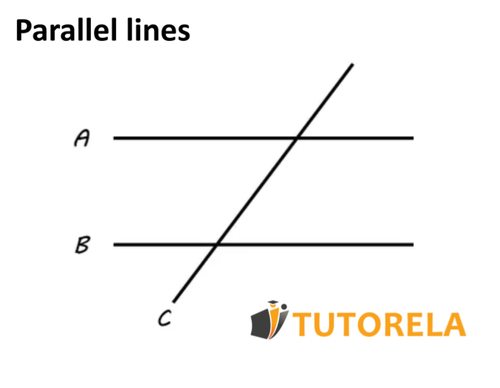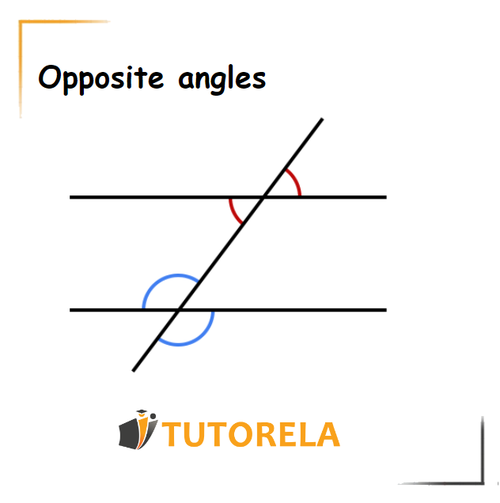Before going deeper into opposite angles, we will pause a moment to visualize the types of scenarios where this type of angle can be found. To make it easier to understand, we will draw two parallel straight lines cut by a secant or transversal, as shown in the following illustration:
Vertically Opposite Angles - Examples, Exercises and Solutions
What are opposite angles?

What do we see here? The transversal intersects with each one of the straight lines and (in our case and are parallel, although this is not required in order to get opposite angles).
With this example in mind, we are ready to move on to the formal definition of opposite angles, which will help us to identify them more easily:
Opposite angles are a pair of angles that arise when two straight lines intersect. These angles are formed at the point of intersection (which we will call the vertex), one in front of the other. Opposite angles are equal.
In the following illustration, we can see two examples of opposite angles, the first pair is marked in red and the second pair in blue.

Suggested Topics to Practice in Advance
Practice Vertically Opposite Angles
Identify the angle shown in the figure below?
Identify the angles shown in the diagram below?
In which of the diagrams are the angles \( \alpha,\beta\text{ } \) vertically opposite?
Is it possible to have two adjacent angles, one of which is obtuse and the other right?
\( a \) is parallel to
\( b \)
Determine which of the statements is correct.
Examples with solutions for Vertically Opposite Angles
Exercise #1
Identify the angle shown in the figure below?
Step-by-Step Solution
Remember that adjacent angles are angles that are formed when two lines intersect one another.
These angles are created at the point of intersection, one adjacent to the other, and that's where their name comes from.
Adjacent angles always complement one another to one hundred and eighty degrees, meaning their sum is 180 degrees.
Answer
Adjacent
Exercise #2
Identify the angles shown in the diagram below?
Step-by-Step Solution
Let's remember that vertical angles are angles that are formed when two lines intersect. They are are created at the point of intersection and are opposite each other.
Answer
Vertical
Exercise #3
In which of the diagrams are the angles vertically opposite?
Step-by-Step Solution
Remember the definition of angles opposite by the vertex:
Angles opposite by the vertex are angles whose formation is possible when two lines cross, and they are formed at the point of intersection, one facing the other. The acute angles are equal in size.
The drawing in answer A corresponds to this definition.
Answer
Exercise #4
Is it possible to have two adjacent angles, one of which is obtuse and the other right?
Video Solution
Step-by-Step Solution
Remember the definition of adjacent angles:
Adjacent angles always complement each other up to one hundred eighty degrees, that is, their sum is 180 degrees.
This situation is impossible since a right angle equals 90 degrees, an obtuse angle is greater than 90 degrees.
Therefore, together their sum will be greater than 180 degrees.
Answer
No
Exercise #5
is parallel to
Determine which of the statements is correct.
Video Solution
Step-by-Step Solution
Let's review the definition of adjacent angles:
Adjacent angles are angles formed where there are two straight lines that intersect. These angles are formed at the point where the intersection occurs, one next to the other, and hence their name.
Now let's review the definition of collateral angles:
Two angles formed when two or more parallel lines are intersected by a third line. The collateral angles are on the same side of the intersecting line and even are at different heights in relation to the parallel line to which they are adjacent.
Therefore, answer C is correct for this definition.
Answer
Colaterales Adjacent
Which type of angles are shown in the diagram?
Which type of angles are shown in the figure below?
Identify the angles in the image below:
Identify the angles marked in the figure below given that ABCD is a trapezoid:
Identify the angles shown in the diagram below?
Exercise #6
Which type of angles are shown in the diagram?
Step-by-Step Solution
First let's remember that corresponding angles can be defined as a pair of angles that can be found on the same side of a transversal line that intersects two parallel lines.
Additionally, these angles are positioned at the same level relative to the parallel line to which they belong.
Answer
Corresponding
Exercise #7
Which type of angles are shown in the figure below?
Step-by-Step Solution
Alternate angles are a pair of angles that can be found on the opposite side of a line that cuts two parallel lines.
Furthermore, these angles are located on the opposite level of the corresponding line that they belong to.
Answer
Alternate
Exercise #8
Identify the angles in the image below:
Step-by-Step Solution
Given that the three lines are parallel to one another, one should note that corresponding angles can be defined as a pair of angles that can be found on the same side of a line intended to intersect two parallel lines.
Additionally, these angles are located on the same level relative to the line they correspond to.
Answer
Corresponding
Exercise #9
Identify the angles marked in the figure below given that ABCD is a trapezoid:
Step-by-Step Solution
Given that ABCD is a trapezoid, we can deduce that lines AB and CD are parallel to each other.
It is important to note that alternate angles are defined as a pair of angles that can be found in the opposite aspect of a line intended to intersect two parallel lines.
Additionally, these angles are positioned at opposite levels relative to the parallel line to which they belong.
Answer
Alternates
Exercise #10
Identify the angles shown in the diagram below?
Step-by-Step Solution
Given that we are not provided with any data related to the lines, we cannot determine whether they are parallel or not.
As a result, none of the options are correct.
Answer
None of the above
Look at the rhombus in the figure.
What is the relationship between the marked angles?
Look at the rectangle ABCD below.
What type of angles are labeled with the letter A in the diagram?
What type are marked labeled B?
The lines a and b are parallel.
What are the corresponding angles?
What angles are described in the drawing?
What are alternate angles of the given parallelogram ?
Exercise #11
Look at the rhombus in the figure.
What is the relationship between the marked angles?
Step-by-Step Solution
Let's remember the different definitions of angles:
Corresponding angles are angles located on the same side of the line that intersects the two parallels and are also situated at the same level with respect to the parallel line they are adjacent to.
Therefore, according to this definition, these are the angles marked with the letter A
Alternate angles are angles located on two different sides of the line that intersects two parallels, and which are also not at the same level with respect to the parallel they are adjacent to.
Therefore, according to this definition, these are the angles marked with the letter B
Answer
A - corresponding; B - alternate
Exercise #12
Look at the rectangle ABCD below.
What type of angles are labeled with the letter A in the diagram?
What type are marked labeled B?
Step-by-Step Solution
Let's remember the definition of corresponding angles:
Corresponding angles are angles located on the same side of the line that cuts through the two parallels and are also situated at the same level with respect to the parallel line to which they are adjacent.
It seems that according to this definition these are the angles marked with the letter A.
Let's remember the definition of adjacent angles:
Adjacent angles are angles whose formation is possible in a situation where there are two lines that cross each other.
These angles are formed at the point where the intersection occurs, one next to the other, and hence their name.
Adjacent angles always complement each other to one hundred eighty degrees, that is, their sum is 180 degrees.
It seems that according to this definition these are the angles marked with the letter B.
Answer
A - corresponding
B - adjacent
Exercise #13
The lines a and b are parallel.
What are the corresponding angles?
Video Solution
Step-by-Step Solution
Given that line a is parallel to line b, let us remind ourselves of the definition of corresponding angles between parallel lines:
Corresponding angles are angles located on the same side of the line that intersects the two parallels and are also situated at the same level with respect to the parallel line to which they are adjacent.
Corresponding angles are equal in size.
According to this definition and as such they are the corresponding angles.
Answer
Exercise #14
What angles are described in the drawing?
Step-by-Step Solution
Since the angles are not on parallel lines, none of the answers are correct.
Answer
Ninguna de las respuestas
Exercise #15
What are alternate angles of the given parallelogram ?
Step-by-Step Solution
To solve the question, we must first remember that a parallelogram has two pairs of opposite sides that are parallel and equal.
That is, the top line is parallel to the bottom one.
From this, it is easy to identify that angle X is actually an alternate angle of angle δ, since both are on different sides of parallel straight lines.
Answer
More Questions
Angles in Parallel Lines
- Calculate α + B: Geometric Angle Addition with Parallel Lines
- Co-interior Angles: Identifying α, β, γ, δ Between Parallel Lines
- Find Angle α in Geometric Diagram with 120° Reference
- Co-interior Angles: Identifying α1, β1, α2, β2 with Parallel Lines
- Calculate 7 Angles with Parallel Lines: Given Angle 115°